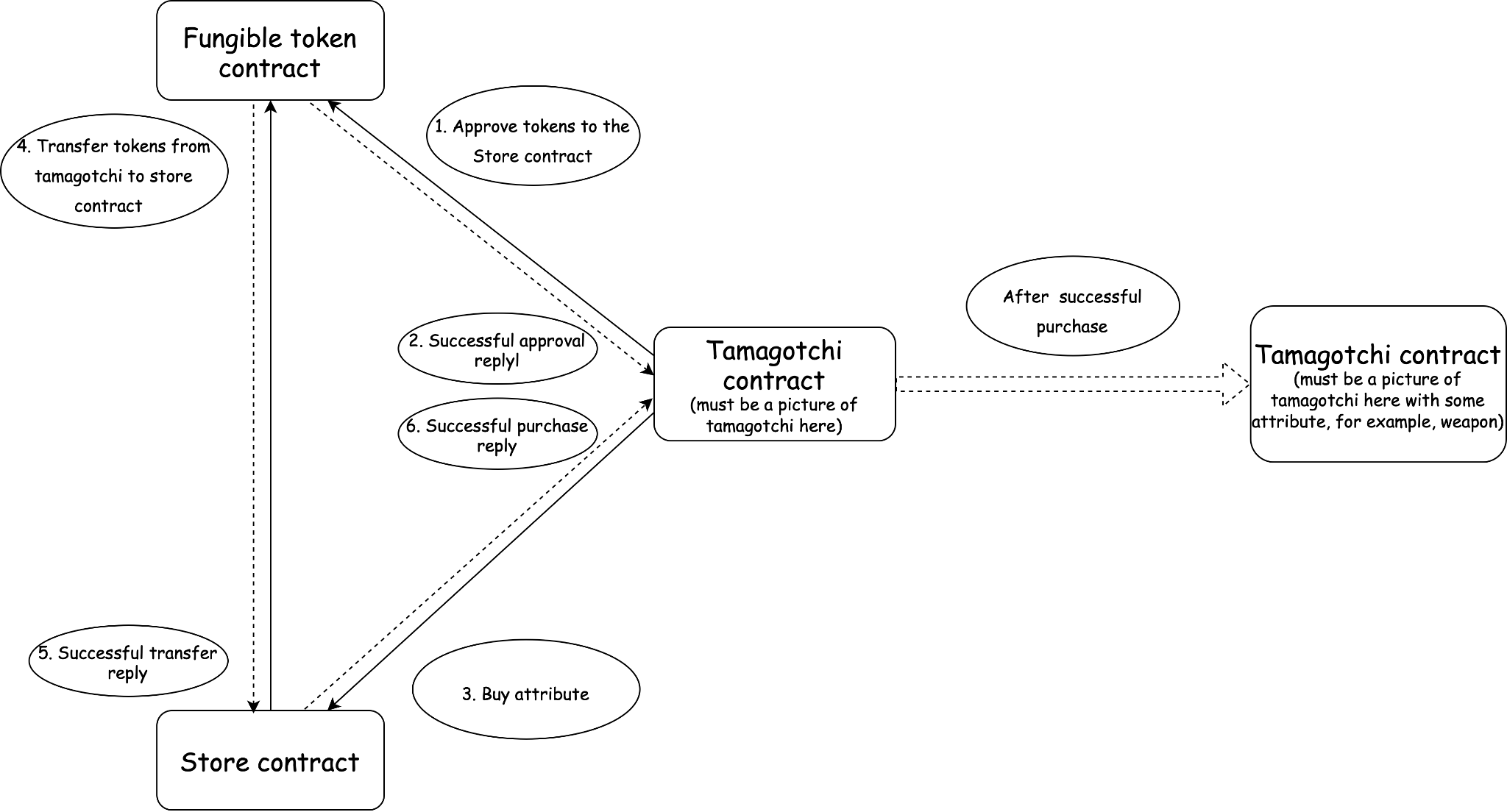Gear Academy:学习如何成为构建去中心化应用程序的专家
第 4 课:Tamagotchi 商店说明
- GearFans
- 发布于 2023-06-06 14:30
- 阅读 3379
本课程涵盖如何使用同质化代币创建销售 Tamagotchi 的合约,探讨交易处理以及如何处理在执行过程中出现错误的交易。
课程总结:
-
本课程涵盖如何使用同质化代币创建销售 Tamagotchi 的合约。
-
Tamagotchi 可以具有各种属性,例如配饰、服装和武器,这将是我们即将推出的 Tamagotchi 对战游戏所必需的。
-
购买属性,Tamagotchi 的余额中必须有足够的代币,并且它必须批准商店转让其代币的合约。
-
我们将探讨交易处理以及如何处理在执行过程中出现错误的交易。
课程目标:
在本课结束时,你会学习到:
-
创建使用同质化代币销售 Tamagotchi 的合约
-
连接同质化代币的概念(来自第 3 课)及其在购买 Tamagotchi 属性中的用途
-
了解如何检查 Tamagotchi 代币余额并批准转移代币的合约。
-
了解如何处理未完成的交易
让我们开始吧!
购买过程包括三个步骤:
-
Tamagotchi 向同质化代币合约发送一条消息,以批准商店合约转移其代币;
-
Tamagotchi 向商店合约发送消息,表明它想要购买的属性;
-
商店合约向同质化代币合约发送一条消息,以将代币转移给自己。如果代币成功转移,商店会将属性添加到 Tamagotchi 属性中。

编码
让我们开始编写智能合约。首先,我们将定义商店合约状态的结构:
pub struct AttributeStore {
admin: ActorId,
ft_contract_id: ActorId,
attributes: BTreeMap<AttributeId, (Metadata, Price)>,
owners: BTreeMap<TamagotchiId, BTreeSet<AttributeId>>,
}我们将使用类型别名来提高代码的可读性:
pub type AttributeId = u32;
pub type Price = u128;
pub type TamagotchiId = ActorId;属性的元数据包含以下字段:
pub struct Metadata {
// the attribute title, for example: "Weapon"
pub title: String,
// description of the attribute
pub description: String,
// URL to associated media (here it should be an attribute picture)
pub media: String,
}让我们定义商店合约必须执行的操作:
-
合约必须创建新的属性并将它们出售给 Tamagotchi 合约;
-
合约必须接收来自 Tamagotchi 合约的消息。
在实现这些功能之前,我们将定义合约商店的 store-io rust 项目工程并编写 lib.rs 文件:
#![no_std]
use gstd::{prelude::*, ActorId};
pub type AttributeId = u32;
pub type Price = u128;
pub type TamagotchiId = ActorId;
#[derive(Encode, Decode)]
pub struct Metadata {
// the attribute title, for example: "Weapon"
pub title: String,
// description of the attribute
pub description: String,
// URL to associated media (here it should be an attribute picture)
pub media: String,
}
#[derive(Encode, Decode)]
pub enum StoreAction {
CreateAttribute {
attribute_id: AttributeId,
metadata: Metadata,
price: Price
},
BuyAttribute {
attribute_id: AttributeId,
}
}
#[derive(Encode, Decode)]
pub enum StoreEvent {
AttributeCreated {
attribute_id: AttributeId,
},
AttributeSold {
success: bool,
},
}
商店合约将接受两种类型的消息:CreateAttribute 和 BuyAttribute。消息执行成功后,它会回复 AttributeCreated 或 AttributeSold。
然后我们将编写程序的基本结构,代码如下:
#![no_std]
use gstd::{msg, prelude::*, ActorId};
use store_io::*;
static mut STORE: Option<AttributeStore> = None;
pub struct AttributeStore {
admin: ActorId,
ft_contract_id: ActorId,
attributes: BTreeMap<AttributeId, (Metadata, Price)>
owners: BTreeMap<TamagotchiId, BTreeSet<AttributeId>)
}
impl AttributeStore {
fn create_attribute(&mut self, attribute_id: AttributeId, metadata: &Metadata, price: Price) {}
async fn buy_attribute(&mut self, attribute_id: AttributeId) {}
}
#[gstd::async_main]
async fn main() {
let action: StoreAction = msg::load().expect("Unable to decode `StoreAction`");
let store: &mut AttributeStore = unsafe { STORE.get_or_insert(Default::default()) };
match action {
StoreAction::CreateAttribute {
attribute_id,
metadata,
price
} => store.create_attribute(attribute_id, &metadata, price),
StoreAction::BuyAttribute { attribute_id } => store.buy_attribute(attribute_id).await,
}
}
#[no_mangle]
unsafe extern "C" fn init() {
let ft_contract_id: ActorId = msg::load().expect("Unable to decode `ActorId`);
let store = AttributeStore {
admin: msg::source(),
ft_contract_id,
..Default::default()
};
STORE = Some(store);
}buy_attribute 函数是异步的,因为商店合约必须向代币合约发送消息并等待它的回复。
现在,让我们实现 create_attribute 函数。这个函数很简单,执行以下步骤:
-
验证发送消息的帐户是合约管理员。
-
确保具有指定 ID 的属性不存在。
-
创建一个新属性
-
发送一个回复,指示属性创建成功。
fn create_attribute(&mut self, attribute_id: AttributeId, metadata: &Metadata, price: Price) {
assert_eq!(msg::source(), self.admin, "Only admin can add attributes");
if self.attributes
.insert(attribute_id, (metadata.clone(), price))
.is_some()
{
panic!("Attribute with that ID already exists");
}
msg::reply(StoreEvent::AttributeCreated { attribute_id }, 0)
.expect("Error in sending a reply `StoreEvent::AttributeCreated");
}接下来,深入了解 buy_attribute 函数的实现。正如我们之前讨论的,此函数负责启动从 Tamagotchi 合约到商店合约的代币转移,并且它必须跟踪同质化代币合约中的交易 ID。为此,我们将在商店合约的状态中添加一个名为 transaction_id 的新字段。
因此,商店合约负责跟踪同质化代币中的交易,并且必须考虑其中当前交易的 ID。让我们将字段 transaction_id 添加到合约状态:
pub struct AttributeStore {
...
transaction_id: TransactionId,
}该字段将存储当前交易的 ID,并允许商店合约轻松跟踪代币的转移状态。有了这个字段,buy_attribute 函数可以启动代币转移,跟踪交易的 ID,并等待同质化代币合约的回复以确认转移成功。
我们还在 store-io 中声明交易 ID 的类型:
pub type TransactionId = u64;接下来,让我们假设以下情况:

-
Tamagotchi 向商店合约发送消息以购买属性;
-
商店合约向同质化代币合约发送消息,并收到代币转移成功的回复;
-
商店合约开始改变其状态。它将指示的属性添加到 Tamagotchi 所有权,但耗尽了 gas。
在这种情况下,代币被转移到商店合约,但 Tamagotchi 没有收到它的属性。为防止这种情况,商店合约必须检测交易何时未完成并相应地继续执行。
让我们向 AttributeStore 结构添加另一个字段:
pub struct AttributeStore {
...
transaction_id: TransactionId,
transactions: BTreeMap<TamagotchiId, (TransactionId, AttributeId)>,
}当商店合约收到来自 Tamagotchi 的购买消息时,它会检查 Tamagotchi 是否已经参与任何未完成的交易。
如果 Tamagotchi 有未完成的交易,商店合约会检索与交易关联的交易编号和属性 ID,并恢复交易。
如果之前的消息没有完成,Tamagotchi 必须发送另一条相同的消息来完成交易。但是,Tamagotchi 可能会发送多条购买消息而没有注意到某些消息未通过。
为了处理这个问题,存储合约检查当前消息中指定的属性 ID,并将其与存储在交易中的属性 ID 进行比较。如果保存的 id 不等于指定的 id,则商店合约会要求 Tamagotchi 完成之前的交易。否则,它将继续挂起的交易。
如果 Tamagotchi 没有未决交易,则存储合约会增加 transaction_id 并保存交易。
async fn buy_attribute(&mut self, attribute_id: AttributeId) {
let (transaction_id, attribute_id) = if let Some((transaction_id, prev_attribute_id)) =
self.transactions.get(&msg::source())
{
// if `prev_attribute_id` is not equal to `attribute_id` then it means that transaction didn`t completed
// we ask the Tamagotchi contract to complete the previous transaction
if attribute_id != *prev_attribute_id {
msg::reply(
StoreEvent::CompletePrevTx {attribute_id: *prev_attribute_id,},
0,
)
.expect("Error in sending a reply `StoreEvent::CompletePrevTx`");
return;
}
(*transaction_id, *prev_attribute_id)
} else {
let current_transaction_id = self.transaction_id;
self.transaction_id = self.transaction_id.wrapping_add(1);
self.transactions
.insert(msg::source(), (current_transaction_id, attribute_id));
(current_transaction_id, attribute_id)
};
let result = self.sell_attribute(transaction_id, attribute_id).await;
self.transactions.remove(&msg::source());
msg::reply(StoreEvent::AttributeSold { success: result }, 0)
.expect("Error in sending a reply `StoreEvent::AttributeSold`");
}请注意,你必须将 CompletePrevTx 事件添加到 StoreEvent 以确保正确的事件跟踪。
编写出售属性的函数。出售属性类似于执行 NFT 转移。我们会将属性 ID 分配给 Tamagotchi 合约。
首先,我们将编写代币转移函数:
async fn transfer_tokens(
transaction_id: TransactionId,
token_address: &ActorId,
from: &ActorId,
to: &ActorId,
amount_tokens: u128,
) -> Result<(), ()> {
let reply = msg::send_for_reply_as::<_, FTokenEvent>(
*token_address,
FTokenAction::Message {
transaction_id,
payload: Action::Transfer {
sender: *from,
recipient: *to,
amount: amount_tokens,
}
.encode(),
},
0,
)
.expect("Error in sending a message `FTokenAction::Message`")
.await;
match reply {
Ok(FTokenEvent::Ok) => Ok(()),
_ => Err(()),
}
}我们已经向代币合约发送了一条消息并处理了它的回复。只有在收到 FTokenEvent::Ok 时,合约才认为发送给代币合约的消息已成功处理。
现在,准备编写出售属性的函数:
async fn sell_attribute(
&mut self,
transaction_id: TransactionId,
attribute_id: AttributeId,
) -> bool {
let (_, price) = self
.attributes
.get(&attribute_id)
.expect("Can`t get attribute_id");
if transfer_tokens(
transaction_id,
&self.ft_contract_id,
&msg::source(),
&exec::program_id(),
*price,
)
.await
.is_ok()
{
self.owners
.entry(msg::source())
.and_modify(|attributes| {
attributes.insert(attribute_id);
})
.or_insert_with(|| [attribute_id].into());
return true;
}首先,合约接收到属性价格,然后调用函数 transfer_tokens。如果代币转移的结果是成功的,它会将属性添加到 Tamagotchi 合约中。
非常好!我们完成了合约逻辑的编写。
现在,赋予 Tamagotchi 购买属性。
我们学到了什么:
-
与同质化代币合约进行通信;
-
如何处理不完整/不完善的交易。
课后作业:
-
将代币提供给 Tamagotchi 合约(此处必须是部署在测试网上的同质化代币合约的链接);
-
向 Tamagotchi 合约添加字段以存储同质化代币合约的地址;
-
添加批准转移其代币的能力(以及相应的用于与同质化代币合约通信的字段 transaction_id);
-
将函数 buy_attribute 添加到 Tamagotchi 合约中;
-
为 Tamagotchi 天添加购买属性,看看它是如何变化的。
对于与前端一致的合约,元数据必须如下:
pub struct ProgramMetadata;
impl Metadata for ProgramMetadata {
type Init = InOut<String, ()>;
type Handle = InOut<TmgAction, TmgEvent>;
type Reply = InOut<(), ()>;
type Others = InOut<(), ()>;
type Signal = ();
type State = Tamagotchi;
}
#[derive(Encode, Decode, TypeInfo)]
pub enum TmgAction {
Name,
Age,
Feed,
Play,
Sleep,
Transfer(ActorId),
Approve(ActorId),
RevokeApproval,
ApproveTokens {
account: ActorId,
amount: u128,
},
SetFTokenContract(ActorId),
BuyAttribute {
store_id: ActorId,
attribute_id: AttributeId,
},
}
#[derive(Encode, Decode, TypeInfo)]
pub enum TmgEvent {
Name(String),
Age(u64),
Fed,
Entertained,
Slept,
Transfer(ActorId),
Approve(ActorId),
RevokeApproval,
ApproveTokens { account: ActorId, amount: u128 },
ApprovalError,
SetFTokenContract,
AttributeBought(AttributeId),
CompletePrevPurchase(AttributeId),
ErrorDuringPurchase,
}